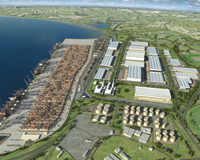Out in the south Essex flatlands a new port is taking shape, with an adjacent 9.25m sq ft logistics park for distribution sheds.
Dubai’s DP World says that its London Gateway Port – which is being built on the site of the former Shellhaven oil refinery in Thurrock – will open in autumn 2013.
The refinery has been flattened and no buildings stand except for one used by DP World itself. But that will soon be changing.
DP World is already talking to companies (which it will not name) interested in building distribution sheds on the logistics park and, while it is happy to have manufacturing uses there too, it is distribution that is expected to dominate.
The port is going to be big (see below). Measured in cargo container sizes, it will add a capacity roughly the same as that of the Port of Felixstowe.
It is already well connected, since the oil refinery had both its own railway line linking into the national network near Tilbury, and a dual carriageway link via the A13 to the M25, so that changing transport mode from sea to rail or road will be relatively straightforward.
The port’s chief executive, Simon Moore, says: “Tenants who want access to a deep water port are looking at our logistics park, and the vast majority plan to be ready when the port opens.
“That is still two years away and there are no buildings here yet, but I would expect work to start next year, though each will have to go through the planning process. I expect most people would want to develop for their own use, but we are open to all development methodologies.”
Moore expects occupiers to be drawn from those that “use deep sea freight, which includes 90% of the high street, with 70% of that coming from Asia”. He adds that the development “will also be attractive to exporters”.
Warehousing capacity
The logistics park could radically change the balance of UK warehousing capacity. As Moore points out, only 10% of this is in the South East, despite the region being such a large market.
John Bell, a director of Glenny, which has a warehouse and industrial division active in the area, doubts that the port will have an adverse impact on the local shed market “because it is aimed at the big tri-modal occupiers”.
But he adds: “If anything, there might be an adverse impact on the Midlands market because, at the moment, goods arrive on container ships and then get driven to Midlands’ depots, from where they are redistributed to the South East. So having warehouses here would cut down on unnecessary vehicle movements.”
Bell believes that the new port’s prelets will be taken by businesses new to an area that has not been offered warehouse capacity on this scale before, rather than by existing local occupiers. His view is widely shared.
Steve Mitchell, director of the logistics and industrial department at Colliers International, says: “It will probably have a positive effect on the local market because if you have a large shed of 250,000 sq ft you are going to need support services from the sub-regional economy, too.
“That could be automotive suppliers, cleaning and so on, and they might take space in Basildon, Grays and other nearby towns where you have older estates, so it could give the market a fillip.”
He adds: “Demand will come from those who need really large sheds. People looking for regional distribution centres for the south east will want to be there.”
Speculative development
Mitchell does not expect to see any speculative development: “I doubt anyone would start on construction without an occupier at the end of it, as they would probably not get the finance at the moment,” he explains.
Steve Ayers, a director of Essex firm Ayers and Cruiks, also sees the port as positive for the local market.
“It offers something we have not really got in south Essex, and I hope it would pull in other things to support it across the area, so there is big potential,” he says. “You can even imagine ship’s caterers or something setting up.”
Ayers adds: “I can’t see it damaging anywhere else in this area because there are no other significant warehouse developments planned, and very little available.
“That market is very price-conscious here. It is also quite slow, but if you do get someone interested they will be serious and you can do a deal.”
Savills director Richard Merryweather agrees: “There are not vast tracts of land nearby that the new port will disadvantage, as it is an estate without much hinterland to impact.”
If industry observers are correct, south Essex will soon be seeing a new type of occupier arrive, bringing some much welcomed spin-off benefits to the local warehouse market.
London Gateway Port
The London Gateway port will have a capacity equal to that of Felixstowe, and has existing direct road and rail connections
• The port will have a cargo capacity of 3.5 million TEU (standard 20 ft-equivalent containers).
• The 9.25m sq ft logistics park has outline planning permission, with units of up to 1.29m sq ft available.
• The scheme has three height zones: 15% of the area to 12m, 30% to 21m and the remainder to 36m, with exceptional permission for up to 41.5m.
• The port will be 25 miles from central London, with a rail link in place and road links to the M25.
• A river frontage of 2.7 km will accommodate six berths and 24 cranes.
• The scheme is expected to start operations in autumn 2013.











